Network Acoustics Muon Streaming System
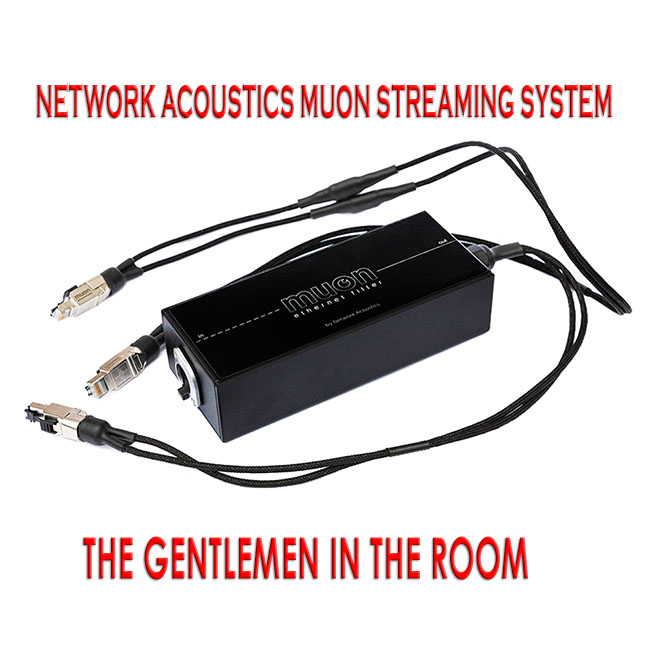
 You should know there is no ‘Russ’ at Network Acoustics; only a Rich and a Rob. Well.. there may be a ‘Russ’ now. Sort of. But that’s a story for later. See, lacking a yacht to dock off Mykonos, in an ill-considered attempt to find my own pandemic-free private Idaho, I moved. Since then, my ethernet streaming never quite sounded as good as it had in the old place. In an (eventually fruitful) attempt to ferret out the cause, I began in earnest consuming any and all reviews of ethernet whys, wherefores, and how-tos. I consulted wizened (and wealthier) audio friends. In the course of this noble quest to ‘get better sound‘ (patented?) I came across a number of reviews of the kind of device in which Rich and Rob at Network Acoustics specializes; ethernet cleaners and cables.
You should know there is no ‘Russ’ at Network Acoustics; only a Rich and a Rob. Well.. there may be a ‘Russ’ now. Sort of. But that’s a story for later. See, lacking a yacht to dock off Mykonos, in an ill-considered attempt to find my own pandemic-free private Idaho, I moved. Since then, my ethernet streaming never quite sounded as good as it had in the old place. In an (eventually fruitful) attempt to ferret out the cause, I began in earnest consuming any and all reviews of ethernet whys, wherefores, and how-tos. I consulted wizened (and wealthier) audio friends. In the course of this noble quest to ‘get better sound‘ (patented?) I came across a number of reviews of the kind of device in which Rich and Rob at Network Acoustics specializes; ethernet cleaners and cables.
I read about how much people loved their ether regens, gigafoils, and special ethernet cables and how network switches might or might not affect the sound (the ‘hey man, it’s just 0’s and 1’s’ people) and so forth. Sure I was skeptical, but never really on the Amazing Randi side of the spectrum. After all, lots of stuff makes a difference by ear in high-end audio that by ‘common sense’ (and sometimes measurement) should not. I heard an improvement in sound when I went from 99-cent outlets to 20-dollar Hubbell outlets, and I don’t care if it’s ‘all in my head’; it was there to me, and that’s what matters. I was, therefore, certainly willing to listen with an open ear and mind to network products. I offered no millions for the debunking of any claims.
Actually, sending tunes via Audirvana or Roon at my old place from a Mac Airport Extreme base station router directly to the Mac mini with a bog standard Terra Grand CAT 7 Jeff-Bezos-approved cable DID sound pretty good last five or so years…. No complaints. That was, however, not the case in my new digs with a new cable company router and network setup (the Mac router is no longer supported by Apple, etc.). There was a certain edge to things, and the tonal beauty I used to have was somewhat MIA, and this with the self-same 2011 Mac mini, feeding the now famed Holo KTE May DAC via my fave AQ Carbon USB cable.
One name that kept coming up with lots of heart and unicorn emojis attached was Network Acoustics’ Richard Trussel, one of the head bartenders there. After reading all kinds of internet love poems regarding their relatively new Eon filter and ethernet cable system and relatively newer and more intricate Muon system, I just had to inquire about reviewing one of them.
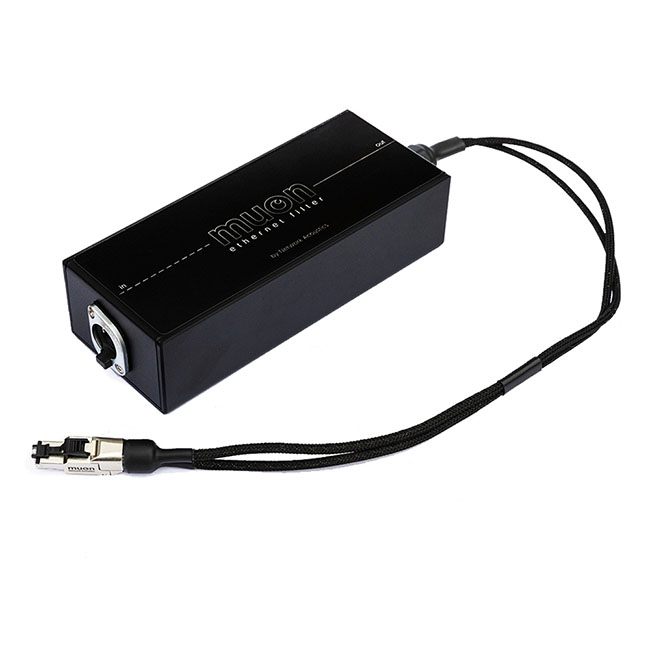
After informing me that my email addressed to Russ (which I’m guessing my left parietal lobe synthesized from ‘Rich’ and ‘Trussel’) should have, in fact, been addressed to Rich (due to the non-existence of Russ), Rich, seemingly unoffended, graciously offered to let me review their premier Muon system consisting of their top o’ the line filtered Muon ethernet cable and their top o’ the line Muon ethernet filter itself.
Adventures in Networking
In recent months I tried a number of ethernet ‘fixing’ tricks to restore the formerly pretty good (if not really great) streaming sound I had in my old digs with my now obsolete Apple Extreme base station router. (Lil’ Bub, RIP; the famed internet kitty was its namesake). Ah, nostalgia. Those were the days; an Apple router and a 3m Jeff Bezos Signature ethernet cable to my mac mini and out to the Holo KTE May DAC, and things were good!!
But here in the new place, there was a persistent hardness to the tone that was fatiguing at times. I tried different cables, even a different amp or two and a power conditioner or two, and on and on. What was it? I thought maybe the router? We had gotten a mesh system (TP-link Deco) with those small white pucks, and I thought, “that can’t be good for sound!” but whether fed from the router directly or from the little white puck, the sound was still a bit shallow and insistent on top. One day I decided to remove the little switch mode power supply from the TP-Link mesh puck and power it from my Sbooster 12v power supply.
Presto! Immediately the fatiguing sound was gone! That stupid little white puck’s cheap power supply was somehow injecting noise into my mains and causing the sound to be brittle. That simple. No magic; no back and forth needed; my shoulders relaxed. After a months-long ferreting out of things, I had found, at least, the primary culprit. There were, however, other contributing culprits like the aforementioned 99-cent (possibly miswired) outlets, but this little gremlin was primary.
I then began to think like an audiophile; ‘if that little power supply was making my ears hurt, now that the pain was gone, could even more pleasure be achieved??’ And cost be damned! (See? Audiophile thinking).
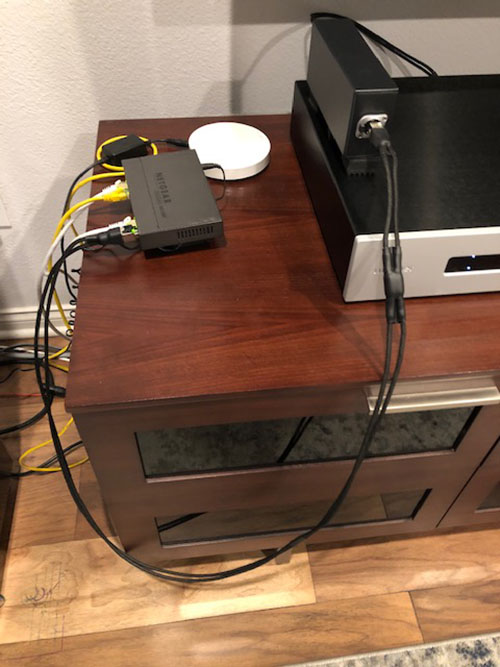
A Parade of Switches
 Audio gurus I trust, like the designer of my favorite integrated amp Fredrik Lejonklou and several guys with crazy forum names, feel a network switch between your router and your streamer sounds better than no switch. Now, this heretical ‘maximalism’ went against every audio tenet n’ fiber I’ve adhered to as regards ‘simplest is best.’
Audio gurus I trust, like the designer of my favorite integrated amp Fredrik Lejonklou and several guys with crazy forum names, feel a network switch between your router and your streamer sounds better than no switch. Now, this heretical ‘maximalism’ went against every audio tenet n’ fiber I’ve adhered to as regards ‘simplest is best.’
And indeed- simplest is often best, though turns out perhaps not in this case! Seems the switch having its own clock, re-clocks, for better or worse, the signal, sometimes offering a better sound after said signal leaves that particular grand central station than when it came in. Switches such as English Electric and SOTM and Nordost et al. try to take this to the extreme with super special clocks and filters etc.
Since I was new to this dirty ethernet concept (but an eager believer something was afoot after that power supply excision!), Leaving high-end audio switches to the side a moment, I decided to experiment with more run-of-the-mill ones. Fredrik Lejonklou recommends the Netgear GS108T ethernet switch, and I believe Linn audio, one of audio’s streaming pioneers, used to recommend the un-managed GS108 or five port gs105 themselves, so I spent like sixty dollars total and bought them used on eBay!
To my shock- yes. Switches do sound different! Now, I’m sure exactly, and precisely the same zeros and ones transit perfectly no matter the switch, but sonically? No. They were not the same. Seems the engineers that designed our data networks forgot to collectively look over at their bespectacled Cal Tech buddies and ask “hey Roy, how do think what we’re designing here will sound!!? To audiophiles, I mean?” Well, in my mind, it’s an oversight:)
Router direct for me was too upfront and a bit comparatively tense at times [NB Since writing this, I’ve changed routers to an Amplifi HD setup and now actually think I prefer router direct!). The GS 105 switch was somehow maybe softer or less punchy than the 108T, and the 108T seemed to me the best balanced, but it was close. I experimented with an ifi elite linear power supply on the 108T as well as an Sbooster but ended up preferring it with its stock switch mode 12v in place. It had a more relaxed sound with the stock supply; go figure. An audio buddy of mine independently came to the exact same conclusion, which helped me feel less delusional.
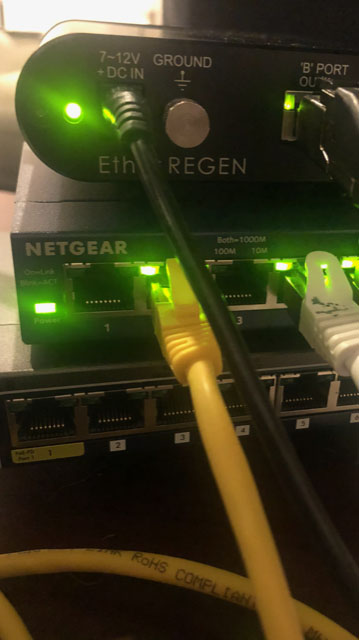
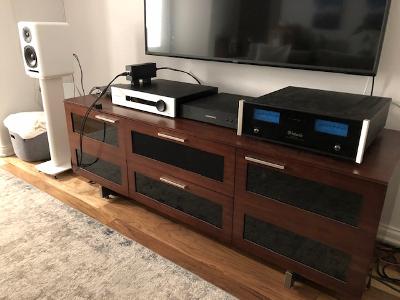
Then another audio buddy sent me some Audioquest Vodka to try along with an Uptone ether regen. That whole experience was eye-opening. For several weeks I easily heard significant musical differences with regen in or out of the circuit, with AQ Vodka in or out replacing cheaper cat 7 (Vodka had more weight/fulsomeness to the sound), and with optical via fiber media converters (with jameco linear power supplies). My mouth was agape at times as I had no clue such sonic differences existed and thought people were making them up.
Some will, of course, think now I am making them up, however, I am very sure they are not made up in my mind. In my digs, they were repeatable, and I had the same preferences every time, regardless of the cost or ‘specialness’ of what I was auditioning. Blindfolded or not (and I wasn’t), I liked what I liked. I make no claim of ‘better’ or ‘worse’ or more or less ‘accurate.’
Over the Muon (cable)
 Even with zero of the 120 recommended hours on the burn-in clock, the Muon cable’s capacious space and relative tonal even-handedness were apparent. Whereas the 1.5m run of Audioquest Vodka I had been listening to between my Netgear G108T switch and Meitner MA3 DAC provided impressive stage width, even in the early going, it was apparent the Muon staged wider, and with electronica like Dominik Eulberg’s ‘Avichrom,’ already was giving me more so than Vodka the distinct impression of the absence of my newish Devore super Nine speakers.
Even with zero of the 120 recommended hours on the burn-in clock, the Muon cable’s capacious space and relative tonal even-handedness were apparent. Whereas the 1.5m run of Audioquest Vodka I had been listening to between my Netgear G108T switch and Meitner MA3 DAC provided impressive stage width, even in the early going, it was apparent the Muon staged wider, and with electronica like Dominik Eulberg’s ‘Avichrom,’ already was giving me more so than Vodka the distinct impression of the absence of my newish Devore super Nine speakers.
There was more stage height, and with certain recordings, and the music seemed almost as though it was spilling forward towards me onto the floor as well; a sort of ‘ball of sound’ certainly apparent but not to the same degree with the AQ Vodka. And then there is the balance. With Jan Bartok playing Janacek piano sonatas, the NA. Muon cable simply sounded a bit more resolved in the midbass and somewhat more organic all around. It’s not the kind of difference that knocks you over immediately, but rather one that becomes a bit more apparent a few tracks in. You simply seem to pay a bit less attention to the reproduction and a bit more attention to the performance. It somehow sounds a bit less ‘artificial’ via the Muon ethernet cable. With very complex atonal dense (and, let’s be honest, partially annoying) instrumentation like Matthew Shipp Trio’s ‘Abandoned,’ the Muon cable sorts this guy from that guy even when they are all doing their thing at once.
I hate to say it has a certain ‘rightness’ to it, but via both my mac mini into the Holo Audio KTE May DAC and via the MA3 DAC with built-in NS1 streamer, the Muon’s overall top to bottom tonal balance really did seem a bit more musically ‘right.’ I also felt the music had a bit more pace via the Muon than with either AQ Vodka or the standard Terra Grand Cat 7 I usually use. In any case, I preferred each time to continue listening to the system with the Muon in place in preference to the other cables I had here. Somehow it spoke more eloquently.

Comparatively, Vodka, while nicely fleshed out and fuller tonally as compared with my Terra Grand 10 dollar ‘bits are bits’ objectivist-approved cable, was again fuller tonally and more impactful. However, it didn’t have quite the resolution or spaciousness of the Muon. Vodka trades resolution for a plumper, rounder midbass forward sound. Muon clears the midbass up and resolves more depth and detail. Depending on ancillary gear, I could certainly see someone preferring the tonal qualities of either.
To wit, with Vodka on the MA3, I could get the sound of this more resolving DAC to approach the more rounded tone of the Holo KTE May. When I sampled Shunyata; both Alpha and Vx were immediately smoother on top than Vodka or Muon with perhaps more filigreed layering than Vodka though less ‘punch’ in the nether regions (which may, of course, be more strictly ‘accurate’ but who knows!?). In some hyper-revealing systems, Shunyata ethernet cables might offer a welcome touch of smoothing and refinement. Vodka’s warmer midbass is pleasant as well, but both cable brands perhaps lack the sheer resolution and accuracy of the Muon. Just be sure you want all this accuracy and resolution. You have 30 days risk-free from purchase to decide…
Perhaps the most notable quality of the Muon cable was its pace- its ability to ‘carry the tune’ or, rather, let the tune be carried. Inserted into the midst of the Meitner/Boazu combo, it was, in this regard, really special.
One thing my favorite reviewer Christian Punter of Hifi Advice, says he doesn’t love about audiophile ethernet cables is they all have a sound. He often prefers standard Cat 6 for this reason (Valueline is his preferred cable to be exact). In the case of the Muon cable, I can definitely say its sound is one of clarity and dynamism as opposed to warmth and fullness. I don’t really hear anything in particular highlighted or suppressed; it just isn’t as warm or ‘delicate’ up top as some other cables I’ve tried.
As a final illustrative example, on the John Nazarenko Trio’s ‘Darn That Dream’ from ‘Invitation,’ I wrote in my notes after having switched over to Muon from AQ Vodka, “absolutely sparkling clarity- huge skyward space and great transient snap .”Vodka was definitely the more subdued of the two, which, depending on your ancillaries, you might welcome. It could be too much of a good thing for some systems.
Now the NA. Muon ethernet cable alone was already very good; clean n’ clear, But what about…

The Full Muon-ty
 The big Muon-owski; the whole enchilada consists of the aforementioned Muon cable and… a black plastic box. I should correct that to a not-inconsiderably-expensive black plastic box, as black plastic boxes go. What’s in this black plastic box? Sorry. It’s proprietary. Government secrets. That sort of thing. I kid! I kiiiid! Apparently, it is, in fact, somewhat proprietary but in essence, they are choke filters that purportedly clean the ethernet signal of extraneous RFI noise/electrical interference, much like a USB/SPDIF converter de-jitters a USB signal.
The big Muon-owski; the whole enchilada consists of the aforementioned Muon cable and… a black plastic box. I should correct that to a not-inconsiderably-expensive black plastic box, as black plastic boxes go. What’s in this black plastic box? Sorry. It’s proprietary. Government secrets. That sort of thing. I kid! I kiiiid! Apparently, it is, in fact, somewhat proprietary but in essence, they are choke filters that purportedly clean the ethernet signal of extraneous RFI noise/electrical interference, much like a USB/SPDIF converter de-jitters a USB signal.
In truth, I don’t care if the box contains an overripe fig and a half-melted watermelon lolly, and the measurements distinctly resemble the outline of a thresher shark in mid-flail. If it brings me closer to my music, that is my end of caring.
Initially, it failed to do this. Having just finished a few-day stint with the almost immediately impressive (and improving daily) Muon ethernet cable, I expected a glimpse of the pure light of my own true inner being upon connecting up the Muon filter. Instead of enlightenment, what I got those first hours was a voi mix of subdued dynamics, smaller scale, and all around muted-ness as compared with the superb balance and effervescence of the Muon ethernet cable I had heretofore been enjoying solo in its in burned-in infancy.
I listened an hour or two and heard the promising beginnings of… something. I let it play overnight. Again much of the next day I lived in uncertainty. It wasn’t doing as much wrong…. but that Muon cable was great solo, and its benefit was immediately apparent. I could live with it on its lonesome.
Always read the manual. When I finally did, I saw that the manual warns at least 20 hours of playtime are needed prior to starting to sound less subdued, and it’s 100 hours to sound more like itself on the way to its final destination of 120 hours for the Muon system to sound “as we designed it to,” per Rich and Rob (but not Russ). So, at hour 15 or so the next day, improvement. More open and spacious for sure. There was the beginnings of spatial cavernousness with Brio Trio, a super well-recorded Swedish jazz piano/drums/bass trio. And there was cavernousness plus terrific bass depth with a jazz trio of French origin led by Stephane Bernard on their mellow out album ‘Night Conversation.’ Stand up bass on this album began to take on a physical presence with a depth and power I hadn’t quite heard from my system before.
At the 40-hour mark or so, I went back and forth, taking the Muon filter out and putting it back in with Leonidas Kavakos leading the charge playing Beethoven’s septet for string and woodwinds in E flat major, and the Muon filter added a certain touch of depth to what was already excellent textured string tone. Additionally, it seemed to ‘blacken’ the background somewhat more and allow a bit more tonal beauty and nuance through.
One night at around the 100-hour mark, I went back and forth on the aforementioned Janacek sonatas with filter and without, and yes, each time I placed the Muon filter in line with the already excellent Muon ethernet cable, there was more; specifically more air seemed to be moving with each piano note or cord and decays from the notes and cords seemed to linger longer. It was as if the instrument was being played in a hall with a bit more reverb or maybe even a bigger hall. I was put in mind of more ‘glow’ or ambiance around the instrument as it was played. Yes, for me, this seemed to add somewhat to the already pretty well-crafted illusion of an actual piano in an actual hall. I also felt the piano had a bit more gravitas; perhaps a fuller ‘less tinkly’ tone up and down the scale.
A/Bing with filter vs. no filter, with the Muon filter in place, on Leonard Elschenbroich’s Beethoven cello concertos, the piano’s lower registers seemed weightier, fuller, and again the increased air; the tone glowed, and the echo in the hall washed over them more so than sans filter. Indeed then, the full Muon-ty system brought more. The image height became even… higher, like ‘climbing up the front wall’ high with Dominik Eulberg’s track ‘Braunkehlchen’ from one of my fave ambient dub albums ‘Avichrom.’
 On Nardis from the John Nazareko Trio album “Some Other Time,” the Muon system gave me the most realistic stick work and feel of actual drum heads flexing under impact I’ve ever heard in my system. And the size of the recorded space was massive, including the best rendition of height I’ve ever had in my system. It gave me the ceiling wherever they were.
On Nardis from the John Nazareko Trio album “Some Other Time,” the Muon system gave me the most realistic stick work and feel of actual drum heads flexing under impact I’ve ever heard in my system. And the size of the recorded space was massive, including the best rendition of height I’ve ever had in my system. It gave me the ceiling wherever they were.
This is just it; the Muon ethernet cable alone provided much of this, but there was somewhat a weightier and airier feel again with the filter in line than with Muon cable alone; those sticks striking drum skins didn’t quite convey the degree of I don’t know, elasticity(?) I got with the Muon filter addition. Perhaps all I am really saying here is that the Muon filter revealed more of what the engineers captured(?) As a passive device, I can only think it’s doing so by way of removing some sort of obfuscation riding on the signal rather than adding some mojo. Yes.
In sum, the overripe fig and watermelon lolly in the box seem to work. With the Muon system, my Mac mini/Holo May gave its closest approach to the Meitner MA3 yet, with the combo sounding more detailed and, at the same time, tonally fuller than it ever has. So, if you’re using a redoubtable mac mini as a streamer (and I love mine!), then a Muon system will take it up a notch or two sonically, rendering it competitive with dedicated streamers like my former Lumin U1 mini (didnt love its app though). Of course, it may well elevate those streamers as well from whatever their baseline might be.
Caveats and Dreams
Is the Muon filter necessary? For me, the Muon ethernet cable was already a change in the system for the better and something I could live with. The Muon filter itself shows you that even an excellent already ‘filtered’ cable like the Muon ethernet cable can benefit from the addition of the Muon filter.
How much? Hard to say. And it will vary depending on your source. For example, my audio buddy with a Grimm music streamer tells me his Muon is of much greater benefit with his lesser streamer system than with the Grimm, which seems somehow buffered to the point he can disconnect the ethernet, go walk the dog, and the same album remains playing when he gets back. On the low-end side of things, my 2011 Mac mini might benefit greatly, but not so much your filtered and re-clocked and buffered 5 or 6 grand server. Can’t really say.
This is why I think the forums are rife with people claiming such and such “makes zero difference and is snake oil.” In their systems, I believe they are 100 percent right! A power ‘conditioner’ probably does jack squat if you have good power in certain areas with minimal variation, just as a Muon system may not do much with a Grimm 10k streamer. Other people are over the Muon (sorry) with their conditioners.
With my Meitner MA3, there’s are audible changes which depending on your preferences, some might call ‘improvements’ going from stock Cat 7 to AQ Vodka, then to Muon and to Muon plus Muon filter. BUT the system sounds great with all of the above. In some regards, I prefer the dynamism, pace, and clarity the Muon system brings, but in some use cases, this could be too much of a good thing. For example, if you prefer a warmer tonal quality, you might opt for AQ Vodka. As it becomes by far the dominant way we listen to our music, exciting times are afoot in high-end audio streaming, and Network Acoustics is definitely on to something with their mysterious black boxes and cables. With their 30-day no questions asked return policy, even non-believing so-called objectivists can give them a try.
It may be lazy of me as a writer, but when something is well said, it is well said, and I think it bears repeating. To quote once again then, Christian Punter of HiFiAdvice.com on such matters, “So here’s the million-dollar question. Is the OEM Cat 6 cable leaving out harmonics and fullness or allowing lots of malicious noise to come through, or is it simply relaying the truth, warts and all? In other words, are the high-end Ethernet cables beautifying the signal, or do they provide a more truthful rendition? Honestly, I have no way of knowing but would argue that it comes down primarily to personal taste and system synergy. What cannot be denied, however, is that ethernet cables really do matter, a lot, actually…” Amen.
Ah, but what of the mythical Russ I emailed first at Network Acoustics? Well, I told Rich about my friends floral design company where irate customers receive help from ‘Victoria,’ their customer service representative, whom, unbeknownst to them, only exists in an email signature. She can be, by turns be, catty or magnanimous. Customers often compliment the florist on Victoria’s warmth and efficiency.
Rich agreed ‘Russ’ would make a great imaginary customer service rep at NA (haven’t consulted Rob yet). Can’t beat his salary, either! So, if their products don’t work out in your system, just email “Russ” at Network Acoustics, and he’ll help you out, or kick it upstairs to Rich and Rob if you don’t like Russ’ attitude. One thing you should know; they tell me there are no or nearly no returns thus far, so Russ is probably on TMZ.com all day like the rest of us work-from-homers. Or gaming.
I bid you peace.


David Abramson
Specifications:
Muon streaming system retail price: from 1695.00 depending on desired ethernet cable length
Muon Ethernet Filter Features
- Input: Neutrik PCB-mounted RJ45 connector.
- Output Connector: Telegaertner RJ45 CAT8.1 connector.
- Cable Length: 50 cm
- Hand-wired entirely using 99.99% high purity UP-OCC conductors.
- 4-core cable architecture designed to operate at 100 Mb/s.
- RFI/EMI Filter: Proprietary filter system.
- Construction: Hand-assembled & individually tested in the UK.
- Enclosure Dimensions: 190 x 78 x 50 mm
- Weight: 300 g
- Warranty: 2 years.
- 30-Day “Try At Home” Money-Back Guarantee.
muon Streaming Cable Features
- Proprietary segregate-core cable 100 mbs cable design.
- Each data line is constructed with its own dedicated in-line filter.
- Bespoke 99.99% high purity UP-OCC conductors.
- Telegartner CAT8.1 connectors with gold-plated contacts.
- Standard 1.50 metre length. (Additional 0.50 metre lengths as required)
- Hand-made and individually tested in the UK.
- Weight: 250 g (for standard 1.00 metre length)
- Warranty: 2 years.
- 30-Day “Try At Home” Money-Back Guarantee
Contact: NetworkAcoustics.com
David’s Associated equipment
Digital source:
Mac Mini 2011 w/Roon and Audirvana Studio; Holo Audio KTE May DAC; Meitner MA 3 DAC
Amplification:
Lejonklou Boazu integrated amplifier; Macintosh MC152 power amplifier
Loudspeakers:
Xavian Perla Esclusiva; Dali Oberon 5; Devore Super Nines; Rel T7X subwoofer
Cables:
Skywire 1400 interconnects; Skywire 1400 speaker cables (with Macintosh amplifier); Linn K20 and K400 speaker cables with Boazu; Audioquest Vodka ethernet cable; Tera Grand CAT 7 ethernet cables; Shunyata alpha and Vx ethernet cables;
Accessories:
Symposium svelte shelf plus and Rollerblock jr. (under Holo DAC); Kef Reference speaker stands (under Xavian speakers)
Stereo Times Masthead
Publisher/Founder
Clement Perry
Editor
Dave Thomas
Senior Editors
Frank Alles, Mike Girardi, John Hoffman, Russell Lichter, Terry London, Moreno Mitchell, Paul Szabady, Bill Wells, Mike Wright, Stephen Yan, and Rob Dockery
Current Contributors
David Abramson, Tim Barrall, Dave Allison, Ron Cook, Lewis Dardick, Dan Secula, Don Shaulis, Greg Simmons, Eric Teh, Greg Voth, Richard Willie, Ed Van Winkle, and Rob Dockery
Music Reviewers:
Carlos Sanchez, John Jonczyk, John Sprung and Russell Lichter
Site Management Clement Perry
Ad Designer: Martin Perry



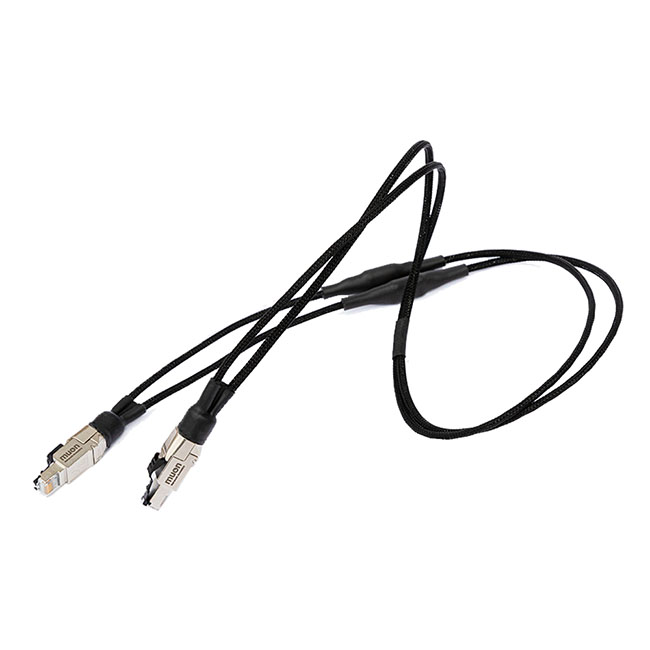




Be the first to comment on: Network Acoustics Muon Streaming System